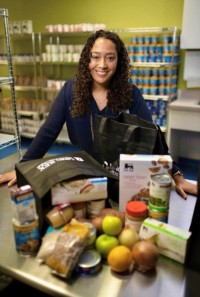The Food Bank Network: working toward a future where no one goes hungry – no matter where we live, where we’re from, who we love, or the color of our skin.
Our network is made of more than 700 incredible pantries, no-cost markets, meal sites, and delivery programs across central and eastern North Carolina.
From school-based pantries and mobile markets, to senior centers and faith-based organizations, each organization is firmly rooted in a local neighborhood or community. Combined, we source and distribute enough food to fuel more than 100 million meals each year – alongside programs that connect community members to essential resources like healthcare, utility assistance, and affordable housing.
Learn more about our network and opportunities to get involved below.

“The staff at the Food Bank of Central & Eastern North Carolina are so friendly and helpful. They always explain procedures and availabilities of food items very patient and thoroughly. There are many options for food items for the patients we serve, and the variety and quality are very great for our patients, especially the produce items that we pick up weekly. We are always happy to see what the Food Bank of Central & Eastern North Carolina have for us.” -Partner
“They provide support not only in physical merchandise (food ) but also resources, such as training and that help keep our food pantry to be efficient. The staff is well trained, professional, and very approachable.” -Partner
“The Food Bank offers updates for continuously growing our Pantry Program which helps us to stay up to date on State mandates for public policies for charitable organizations.” -Partner
Network Values
Our 700+ local partners hold people facing hunger at the center of every decision – from the food we source and distribute, to the programs we invest in, to the policies we advocate for. Within this commitment, our network is guided by a set of core values:
Network Membership
Our network is here to ensure everyone in our communities has access to food and other essential resources – no matter where we live, where we’re from, who who we love, or the color of our skin. With so many changes at the state and federal level that directly impact this vision, we are currently assessing network capacity and determining recruitment priorities based on:
- Geographic and demographic gaps in service availability
- Overall availability of healthy, culturally-familiar and versatile foods
- Capacity of existing partners
- Scope of services and resources each organization currently offers
In the meantime, please don’t hesitate to reach out if your organization is in an underserved area and has the capacity to support. There are many ways to get involved locally. Just one example: our Pop-up Markets offer a solid pathway to improve resource availability in the community and build local capacity to host a formal pantry or no-cost market along the way.
Join the Fight
We’re honored and humbled by the outpouring of support from community leaders who share our vision for a hunger-free future. With more than 700 partners across our service area, most communities currently host at least one food assistance organization that is part of the Food Bank network. We encourage you to explore collaboration opportunities with the agency closest to you — or check out the FAQ below for other ways to make a difference.
Frequently Asked Questions
Join Our Movement to End Hunger For Good
There are a host of ways to make a difference right now in the fight to end hunger. If you’re able, please take a minute to lend your time, your voice, or your financial support as we work to meet rising challenges head on!

